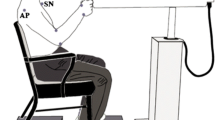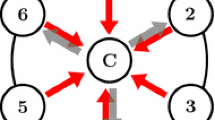Abstract
We tested several predictions of a recent theory that combines the ideas of control with referent configurations, hierarchical control, and the uncontrolled manifold (UCM) hypothesis. In particular, we tested a hypothesis that unintentional changes in hand coordinate can happen following a long-lasting transient perturbation. The subjects grasped a handle with the right hand, occupied an initial position against a bias force produced by the HapticMaster robot, and then tried not to react to changes in the robot-produced force. Changes in the force were smooth and transient; they always ended with the same force as the bias force. The force-change amplitude and the time the force was kept at the new level (dwell time) varied across conditions. After the transient force change was over, the handle rested in a position that differed significantly from the initial position. The amplitude of this unintentional movement increased with the amplitude of transient force change and with the dwell time. In the new position, the across-trials joint configuration variance was mostly confined to a subspace compatible with the average handle coordinate and orientation (the UCMs for these variables). We view these results as the first experimental support for the hypothesis on back-coupling between the referent and actual body configurations during multi-joint actions. The results suggest that even under the instruction “not to react to transient force changes,” the subjects may be unable to prevent unintentional drift of the referent configuration. The structure of joint configuration variance after such movements was similar to that in earlier reports on joint configuration variance after intentional movements. We conclude that the intentional and unintentional movements are products of a single neural system that can lead to intentional and unintentional shifts of the referent body configuration.





Similar content being viewed by others
References
Adamovich SV, Levin MF, Feldman AG (1997) Central modifications of reflex parameters may underlie the fastest arm movements. J Neurophysiol 77:1460–1469
Ambike S, Paclet F, Zatsiorsky VM, Latash ML (2014) Factors affecting grip force: anatomy, mechanics, and referent configurations. Exp Brain Res 232:1219–1231
Bernstein NA (1967) The co-ordination and regulation of movements. Pergamon Press, Oxford
Bizzi E, Polit A, Morasso P (1976) Mechanisms underlying achievement of final head position. J Neurophysiol 39:435–444
De Ruiter CJ, De Haan A, Jones DA, Sargeant AJ (1998) Shortening-induced force depression in human adductor pollicis muscle. J Physiol 507:583–591
DiZio P, Lackner JR (1995) Motor adaptation to Coriolis force perturbations of reaching movements: endpoint but not trajectory adaptation transfers to the nonexposed arm. J Neurophysiol 74:1787–1792
Domkin D, Laczko J, Jaric S, Johansson H, Latash ML (2002) Structure of joint variability in bimanual pointing tasks. Exp Brain Res 143:11–23
Domkin D, Laczko J, Djupsjöbacka M, Jaric S, Latash ML (2005) Joint angle variability in 3D bimanual pointing: uncontrolled manifold analysis. Exp Brain Res 163:44–57
Feldman AG (1966) Functional tuning of the nervous system with control of movement or maintenance of a steady posture. II. Controllable parameters of the muscle. Biophysics 11:565–578
Feldman AG (1986) Once more on the equilibrium-point hypothesis (λ-model) for motor control. J Mot Behav 18:17–54
Feldman AG (2011) Space and time in the context of equilibrium-point theory. Wiley Interdiscip Rev Cogn Sci 2:287–304
Feldman AG, Adamovich SV, Levin MF (1995) The relationship between control, kinematic and electromyographic variables in fast single-joint movements in humans. Exp Brain Res 103:440–450
Gera G, Freitas SMSF, Latash ML, Monahan K, Schöner G, Scholz JP (2010) Motor abundance contributes to resolving multiple kinematic task constraints. Mot Control 14:83–115
Hinder MR, Milner TE (2003) The case for an internal dynamics model versus equilibrium point control in human movement. J Physiol 549:953–963
Kawato M (1999) Internal models for motor control and trajectory planning. Curr Opin Neurobiol 9:718–727
Kelso JA, Holt KG (1980) Exploring a vibratory systems analysis of human movement production. J Neurophysiol 43:1183–1196
Lackner JR, DiZio P (1994) Rapid adaptation to Coriolis force perturbations of arm trajectory. J Neurophysiol 72:1–15
Latash ML (1994) Reconstruction of equilibrium trajectories and joint stiffness patterns during single-joint voluntary movements under different instructions. Biol Cybern 71:441–450
Latash ML (2010) Motor synergies and the equilibrium-point hypothesis. Mot Control 14:294–322
Latash ML (2012) The bliss (not the problem) of motor abundance (not redundancy). Exp Brain Res 217:1–5
Latash ML, Gottlieb GL (1990) Compliant characteristics of single joints: preservation of equifinality with phasic reactions. Biol Cybern 62:331–336
Latash ML, Gottlieb GL (1991) Reconstruction of elbow joint compliant characteristics during fast and slow voluntary movements. Neurosci 43:697–712
Latash ML, Aruin AS, Zatsiorsky VM (1999) The basis of a simple synergy: reconstruction of joint equilibrium trajectories during unrestrained arm movements. Hum Move Sci 18:3–30
Latash ML, Shim JK, Zatsiorsky VM (2004) Is there a timing synergy during multi-finger production of quick force pulses? Exp Brain Res 159:65–71
Latash ML, Shim JK, Smilga AV, Zatsiorsky V (2005) A central back-coupling hypothesis on the organization of motor synergies: a physical metaphor and a neural model. Biol Cybern 92:186–191
Latash ML, Scholz JP, Schöner G (2002) Motor control strategies revealed in the structure of motor variability. Exer Sport Sci Rev 30:26–31
Latash ML, Scholz JP, Schöner G (2007) Toward a new theory of motor synergies. Mot Control 11:276–308
Latash ML, Friedman J, Kim SW, Feldman AG, Zatsiorsky VM (2010) Prehension synergies and control with referent hand configurations. Exp Brain Res 202:213–229
Lee EJ, Herzog W (2009) Shortening-induced force depression is primarily caused by cross-bridges in strongly bound states. J Biomech 42:2336–2340
Martin V, Scholz JP, Schöner G (2009) Redundancy, self-motion, and motor control. Neural Comput 21:1371–1414
Mattos D, Latash ML, Park E, Kuhl J, Scholz JP (2011) Unpredictable elbow joint perturbation during reaching results in multijoint motor equivalence. J Neurophysiol 106:1424–1436
Oskouei AE, Herzog W (2005) Observations on force enhancement in submaximal voluntary contractions of human adductor pollicis muscle. J Appl Physiol 98:2087–2095
Partridge LD, Partridge LD (1993) The nervous system: its function and interaction with the world. The MIT Press, Cambridge
Pinninger GJ, Creswell AG (2007) Residual force enhancement after lengthening is present during submaximal plantar flexion and dorsiflexion actions in humans. J Appl Physiol 102:18–25
Schmidt RA, McGown C (1980) Terminal accuracy of unexpected loaded rapid movements: evidence for a mass-spring mechanism in programming. J Mot Behav 12:149–161
Scholz JP, Schöner G, Latash ML (2000) Identifying the control structure of multijoint coordination during pistol shooting. Exp Brain Res 135:382–404
Shapkova EYu, Shapkova AL, Goodman SR, Zatsiorsky VM, Latash ML (2008) Do synergies decrease force variability? A study of single-finger and multi-finger force production. Exp Brain Res 188:411–425
Shim JK, Latash ML, Zatsiorsky VM (2003) The central nervous system needs time to organize task-specific covariation of finger forces. Neurosci Lett 353:72–74
Slifkin AB, Vaillancourt DE, Newell KM (2000) Intermittency in the control of continuous force production. J Neurophysiol 84:1708–1718
Solnik S, Pazin N, Coelho C, Rosenbaum DA, Scholz JP, Zatsiorsky VM, Latash ML (2013) End-state comfort and joint configuration variance during reaching. Exp Brain Res 225:431–442
Tsay A, Savage G, Allen TJ, Proske U (2014) Limb position sense, proprioceptive drift and muscle thixotropy at the human elbow joint. J Physiol 592:2679–2694
Vaillancourt DE, Russell DM (2002) Temporal capacity of short-term visuomotor memory in continuous force production. Exp Brain Res 145:275–285
Wilhelm L, Zatsiorsky VM, Latash ML (2013) Equifinality and its violations in a redundant system: multi-finger accurate force production. J Neurophysiol 110:1965–1973
Wolpert DM, Ghahramani Z, Jordan MI (1995) An internal model for sensorimotor integration. Science 269:1880–1882
Zatsiorsky VM, Prilutsky BI (2012) Biomechanics of skeletal muscles. Human Kinetics: Urbana, IL
Acknowledgments
The study was in part supported by an NIH Grant NS-035032.
Author information
Authors and Affiliations
Corresponding author
Rights and permissions
About this article
Cite this article
Zhou, T., Solnik, S., Wu, YH. et al. Unintentional movements produced by back-coupling between the actual and referent body configurations: violations of equifinality in multi-joint positional tasks. Exp Brain Res 232, 3847–3859 (2014). https://doi.org/10.1007/s00221-014-4059-x
Received:
Accepted:
Published:
Issue Date:
DOI: https://doi.org/10.1007/s00221-014-4059-x




